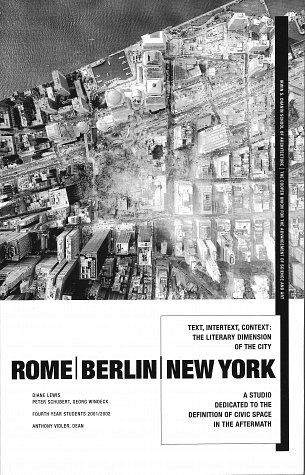World Architecture Congress UIA Berlin 2002
Our fourth year urban architecture design studio at The Cooper Union was selected to represent the United States of America at the 21st World Architecture Congress UIA in Berlin. The book Rome Berlin New York was published to present the work of the studio and complement the exhibition. Professor Diane Lewis, Professor Peter Schubert, Professor Georg Windeck
Dean Anthony Vidler
Now prepare to make a fantastic assumption. Rome was not a human inhabitation, but also a psychic substance or creature, with a similarly rich and substantial past in which not only whatever has been in existence has never perished but also, parallel to the last phase of development, all earlier incarnations live on.
Sigmund Freud
Civilization and its Discontent, 1927
The project is a study of the plans of the cities of Rome, Berlin, and New York in order to propose a 21st Century civic institution and define its site with significance in regard to Freud's definition of the city as a psychic entity. This was the assignment to the fourth year architecture students at The Cooper Union on September 7, 2001. Four days later the destruction of the World Trade Center occurred.
All of the participants in this class witnessed the 9/11 event with their own eyes. Whether seen from the roof of the Cooper Union building or within the streets of New York, each student and faculty member proceeded to address the civic space of architecture at the scale of the city, past, present, and future, for one semester. Although there is only one project specifically proposed for the Ground Zero site, the subject as a whole can be seen as an address to the question. This study as conducted in the aftermath of this monumental urban event is motivated toward the creation of intimate civic space with inventive contemporary program. As the city is now open for redefinition, the project can be considered to address the future conscience necessary to solve the problems posed. The institutions proposed integrate an understanding of the relation between form, site, and program within a literary vision of the possibility of the city.
Prof. Diane Lewis

